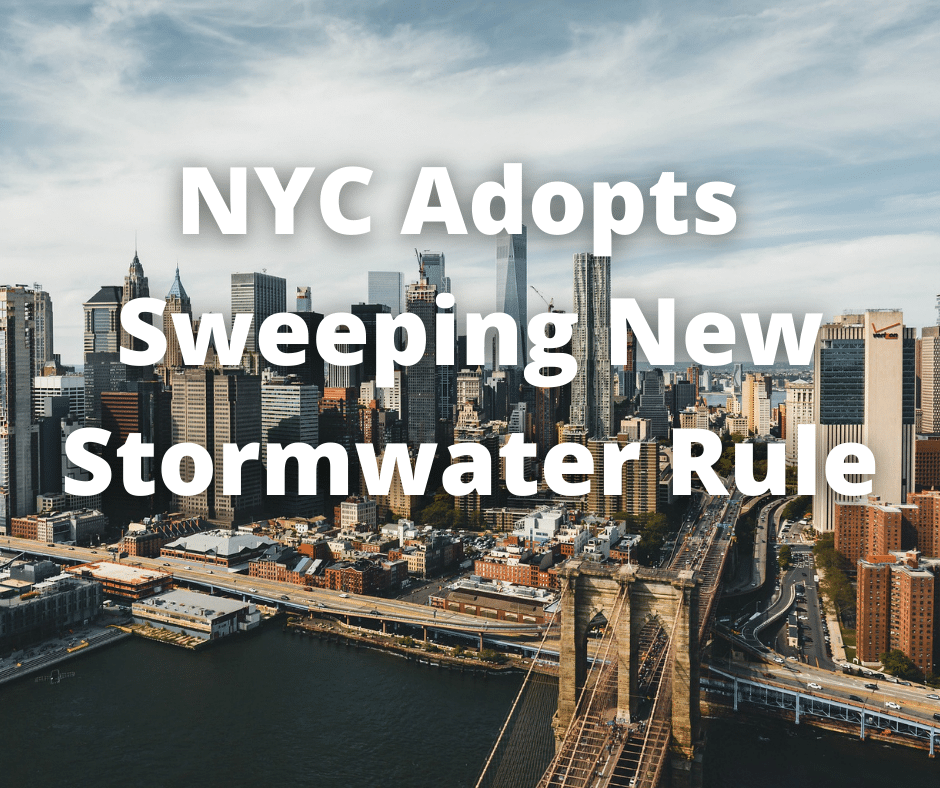Blog

NYC Adopts Sweeping New Stormwater Rule
In February 2022, the New York City Department of Environmental Protection (DEP) adopted the Unified Stormwater Rule (USWR) to update the stormwater management requirements for all new development and redevelopment sites that discharge to City sewers. The USWR amends Title 15, Chapter 19.1 and Chapter 31 of the Rules of the City of New York, which relate to stormwater construction permitting and site/house connection proposals, respectively. To support implementation of the USWR, DEP also released the New York City Stormwater Manual, which replaces and harmonizes the 2018 NYC MS4 Manual, 2012 Stormwater Rule Manual, and 2012 Guidelines for Design of Detention Facilities. This blog post summarizes some of the USWR’s most consequential amendment provisions.
Chapter 19.1 Amendments
Under the Chapter 19.1 amendments, the construction permit requirements that previously only applied to Municipal Separate Storm Sewer System (MS4) areas now apply to Combined Storm Sewer (CSS) areas as well. Approximately 40% of New York City is within an MS4 area, meaning that stormwater is collected by City-owned conveyances like gutters and storm drains and discharged directly to surface waters without processing at a wastewater treatment plant (WWTP). The remaining approximately 60% of the City is within a CSS area, where stormwater is collected in a combined sewer and stormwater pipe network and sent to a WWTP for processing, except during heavy rainfall events where untreated sewage and stormwater are discharged to surface waters as a combined sewer overflow.
In both MS4 and CSS areas, developers must first obtain a stormwater construction permit before they commence any “development activity” in connection with a “covered development project.” The USWR amended the definition of development activity to include not only soil disturbance but also now the “creation of impervious surface.” The USWR also amended the definition of “covered development project” to include any development activity that involves or results in: (1) soil disturbance of an area of 20,000 square feet or more (previously one acre, or 43,560 square feet, or more), or (2) the creation of 5,000 square feet or more of impervious surface or a “covered maintenance activity”—roadway maintenance involving an area of 20,000 square feet or more.
The Chapter 19.1 amendments require that Stormwater Pollution Prevention Plans (SWPPPs), which must be submitted with stormwater construction permit applications, include post-construction stormwater management practices for: (1) development activities for covered development projects listed in Table 2.3 of the NYC Stormwater Manual, with limited exceptions; or (2) development activities that alter hydrology, reduce surface perviousness, or include the reconstruction of an impervious surface that disturbs soil. The NYC Stormwater Manual provides the detailed requirements for incorporating stormwater management practices into SWPPPs.
The Chapter 19.1 amendments also exempt various development activities from stormwater construction permitting requirements, depending on when certain other applications were filed or permits issued. For example, the Chapter 19.1 amendments exempt any development activity for which the NYS Department of Environmental Conservation (NYSDEC) issued one of the following before June 1, 2019: (a) a letter of acknowledgment of the applicant’s notice of intent to seek coverage under a State Pollutant Discharge Elimination System (SPDES) general permit for construction activity, or (b) a valid individual SPDES permit for construction activity.
Chapter 31 Amendments
The Chapter 31 amendments relate to house and site connection proposals for use of the City’s sewer system. The Chapter 31 amendments do not apply to any site with a sewer availability certification issued before February 15, 2022. The amendments also include specific instructions for certain sites subject to a recent rezoning.
The amendments revise the definition of “house connection proposal” to include “Fee Simple One (1), Two (2) or Three (3) Family Dwelling Units less than 20,000 square feet in total site area, connecting to a sewer that fronts the site.” A “site connection proposal” covers existing or proposed developments other than those qualifying for a house connection proposal.
Owners proposing to connect to a City sewer, a private sewer, a private drain, or an approved outlet to serve an existing or a proposed development still must file a sewer certification application. But numerous sewer certification application types cannot be self-certified. The Chapter 31 amendments add the following to the list of self-certification exclusions: (i) applications for projects not filed with the New York City Department of Buildings; (ii) applications for proposed developments where a sewer does not front the property but is otherwise available; and (iii) applications for proposed developments where a storm or combined sewer extension is feasible.
Sewer availability certification applications must now include: a site plan depicting the proposed sanitary discharge; stormwater volume requirement; the actual stormwater release rate from the site; and the maximum stormwater release rate, in accordance with the NYC Stormwater Manual and Chapter 31 requirements. Site plans included with the certification applications must detail the proposed stormwater management facilities necessary for on-site retention and/or detention of stormwater runoff, to ensure compliance with the USWR and Chapter 19.1. The NYC Stormwater Manual provides the comprehensive requirements for the stormwater management practices required by Chapter 31.
Before the USWR, the stormwater performance standard applied to sewer availability certification and connection permit applications for discharges to only the combined sewer system. The Chapter 31 amendments now apply the stormwater performance standard to discharges to the MS4 storm sewer system as well. The amendments also revise the maximum stormwater release rates and volume requirements.
The USWR significantly changes the way that stormwater discharges and sewer system discharges are managed and permitted in New York City. Project applicants must account for the complexities of this permitting process and the additional time necessary to ensure compliance when creating a development timeline and undertaking contractor bidding. Otherwise, schedules and costs may be far out of line with the new regulatory reality.